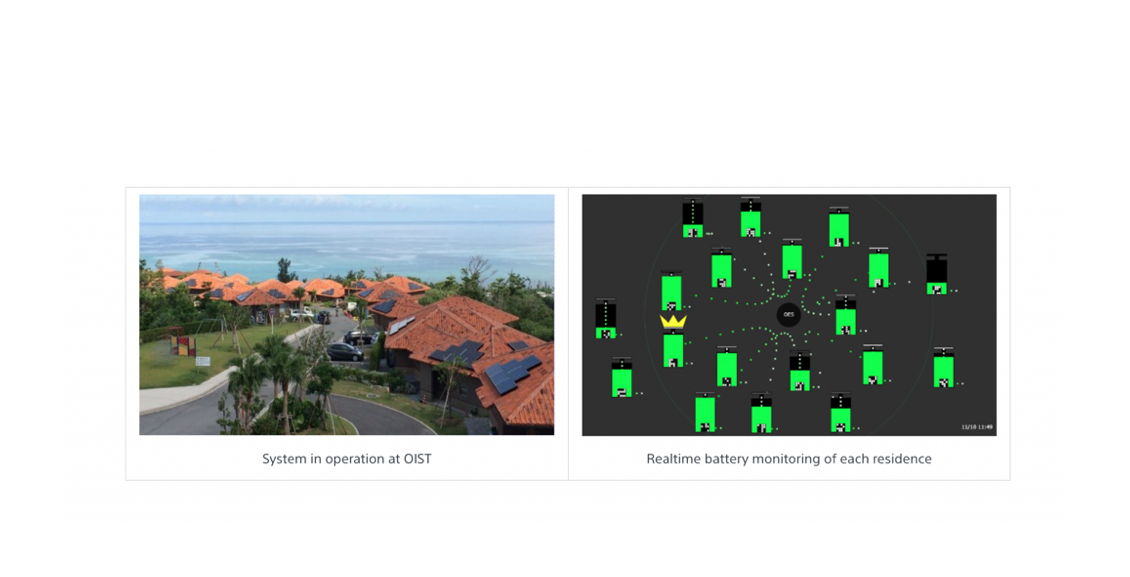Promote locally produced & consumed renewable energy,
work towards a sustainable society
On December 1, 2020, Sony Computer Science Laboratories, Inc. (Sony CSL; President & CEO: Hiroaki Kitano) will make its Autonomous Power Interchange System (APIS)—the power-interchange management software that comprises the core module of microgrid Open Energy System™ (OES) and the proprietary peer-to-peer (P2P) power interchange technology they develop open source, meaning it will be freely available to the public.
In recent years, climate change has become ever more serious, demanding that we undertake a practicable, large-scale shift from fossil fuel energy to renewable energy—every day counts. The adoption of renewable energy can take many forms, but Sony CSL has undertaken research and development of electric power systems known as microgrids, which are decentralized, highly scalable, and exceptionally resilient to natural disasters. A microgrid utilizes decentralized, renewable energy sources, including solar and others, to generate, stores and distributes power for use by a specific area while reducing greenhouse gas emissions. This is a highly resilient power system that minimizes the transmission and distribution distance from generation to consumption, which eventually reduces the impact of physical damage wrought by natural disasters.
Sony CSL has done pilot projects of microgrid OES related technologies in locations including Africa and Okinawa, Japan. At the Okinawa Institute of Science and Technology (OIST), we have provided power to faculty housing units for five years, confirming that our technology is both stable and practical. Sony CSL’s mission is to “carry out research for the future of humanity,” and if we are to fulfill that mission, it is our responsibility to deliver research results using the best methods available to us.
This is why we have made our independently developed Autonomous Power Interchange System (APIS) software open source: to help tackle climate change, an issue that impacts all humankind. We believe that making this technology open source will promote all sorts of open innovation, energizing a variety of stakeholders to come together, accelerating research into transformation towards renewable energy at universities and scientific institutes, and spurring the emergence of microgrid-related startups. Thus, we expect that the adoption of this technology is likely to occur much more rapidly and widely than if it were in the sole possession of Sony CSL.
OES & APIS Development Background
Currently, most conventional alternating current (AC) microgrids rely on cogeneration that uses oil or gas as a stabilizing energy source, which means CO2 emissions will never reach zero. Also, without sufficient battery capacity, there are limits to how much renewable energy you can bring in, which in turn is due to the limits of how flexibly AC generators can respond to the sudden fluctuations of solar energy and other renewables(i.e. the reverse power flow problem). These are just some of the practical problems at play.
Open Energy System (OES) technology overcomes these problems with direct current (DC) microgrids. Decentralized power generators using solar and other renewables and decentralized power storage equipment are directly connected within the grid. The Autonomous Power Interchange System (APIS) is the software that acts as the “core module” to make this technology possible. It has three distinguishing features.
- Flexible grid expansion: Because power interchange is autonomous, the microgrid can be expanded flexibly, without having to redesign the system from the ground up.
- Effective use of renewables: Because the power interchange occurs between decentralized power generators and decentralized power storage equipment, it is possible to use renewable energy effectively despite fluctuations in the amount of power generated.
- Resilience: Because of these characteristics, it is possible to build a power system with high resilience.
Although the merits of OES-style DC microgrid technology are often discussed, the fact is that very little information is out there about how these systems are developed and managed, and how they could be implemented in R&D projects or used by entrepreneurs. In order to change that, we developed our proprietary OES decentralized-battery direct current (DC) microgrid—which includes decentralized battery systems that can work autonomously in concert with the grid—and the APIS software to manage it.
APIS Functionality
Through P2P power interchange between decentralized batteries, the APIS software that we are now making open source allows for the creation of microgrids that operate primarily on renewable energy and offer a power system with increased resilience. This system can perform power interchange autonomously and flexibly, responding to the needs of individual residences and facilities within a community, and to the characteristic fluctuations of renewable energy. The balance of supply and demand within the community is carefully regulated, leading to greater energy independence.
◆ Emulation of Microgrid Power Interchange on a PC
If you are considering the adoption of microgrid technology, with APIS you can perform operation verification of power interchange under various parameters.
◆ Control of a Microgrid’s Battery Systems
By setting up APIS together with device drivers for each battery, you can build a flexible microgrid system that works with various types of hardware.
Features of an APIS Microgrid
- Improve use efficiency of renewable energy sources (which are thinly distributed and highly variable over time) due to coordinated control of decentralized batteries.
- Scalability. Start with as few as two batteries, and flexibly and easily expand the system from there.
- A system that can continue emergency operations even in the event of microgrid failure.
- Remote monitoring that offers automatic notification of any failure, making system operations easier.
- After a power outage, easy to do a “black start”—restoring power without relying on an external power source.
- Effective utilization and sharing of power within a given region, even in areas with no large power plant or reliable power grid.
Autonomous, decentralized & coordinated control of power interchange
Pilot Project
At the Okinawa Institute of Science and Technology (OIST), 19 faculty residences have had energy systems—featuring solar panels and batteries and utilizing APIS technology—installed and operational since December 2014. This OIST energy system successfully provides approximately 10 hours of continuous power, even when the regular AC power supply is shut down for inspection. Furthermore, it provides up to 60.8% of daily power supply, and an annual average of 33.3% of total power supply comes from renewables. (Sony CSL measurements from 2017).
In this faculty housing project, our aim was to verify that a conventional power system and OES could work in concert. The capacity for each home was set at 3.5kW of photovoltaic (PV) cells, and a 4.8kWh battery, meaning OES would meet between 30% and 60% of the total power demand. However, by strengthening this capacity, it would be possible to achieve a greater share for renewable energy. (According to our simulations, PV10.0kW + battery 15.0kWh capacity would mean 93% of power coming from renewable energy) (This project was supported by the “Subtropical and Island Energy Infrastructure Technology Research Subsidy Program,” Okinawa Prefectural Government. Also, the test is being held in collaboration with Okinawa Institute of Science and Technology Graduate University (OIST), Okisokou、Ltd., and Sony Business Operations,Inc.)
Comment from Hiroaki Kitano, Sony CSL President & CEO
“Sony CSL’s mission is to carry out research for the future of humanity. In order to fulfill that mission our efforts are not limited to OES.We are also undertaking research and implementation of projects ranging from Synecoculture™ farming to low earth orbit optical communications networks. The environmental challenges we are facing are not just about concentrations of carbon dioxide. We must also ask: How can we sustain or even increase biodiversity? Is there a technology that will allow us to dramatically reduce our demand for resources, while sustaining or improving our current living standards? How will we achieve the societal changes needed to successfully tackle these challenges? In particular, when it comes to climate change, we need to take actions which proceed on the assumption that we are already in danger of “Climate Departure”, where the climate undergoes irreversible change. With this in mind, it is vital that we are able to provide stable supplies of power in unstable environments through the swift and widespread adoption of renewable energy systems such as the ones we see in OES. By making OES/APIS open source, we hope to increase the number of stakeholders in this project and contribute to the realization of a sustainable society.”
Open Energy System(OES)
URL:https://www.sonycsl.co.jp/sp/287/
Autonomous Power Interchange System(APIS)
URL:https://www.sonycsl.co.jp/tokyo/11481/
Media inquiries:
Corporate Communications, Sony Computer Science Laboratories, Inc.
csl-pr@csl.sony.co.jp



